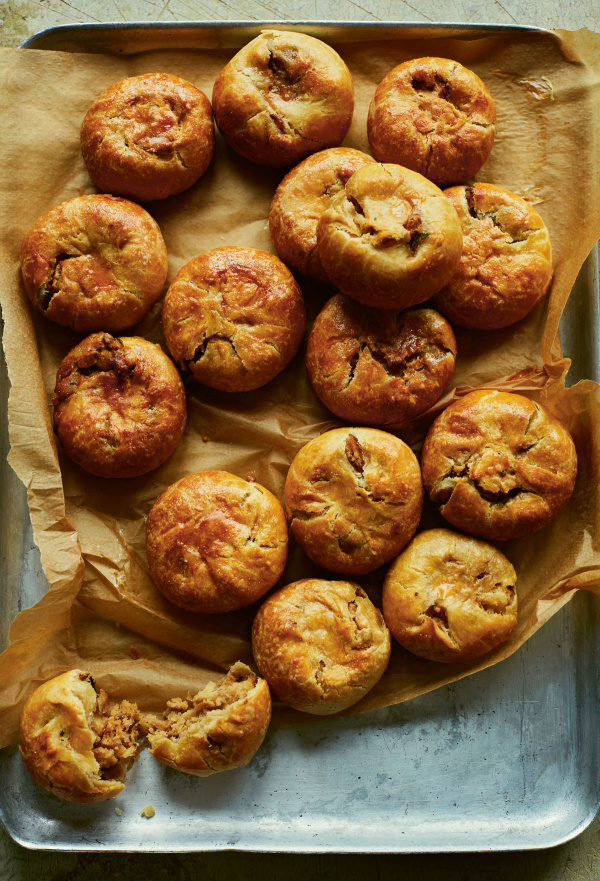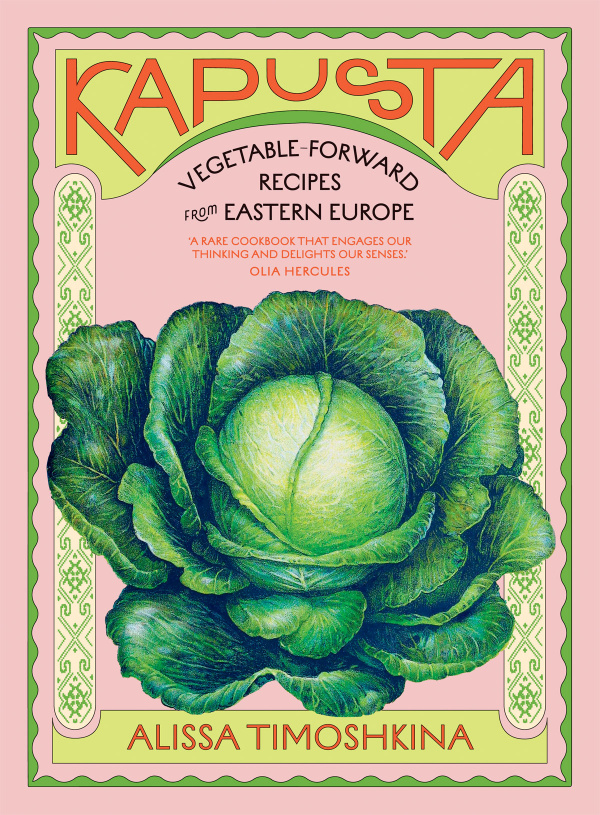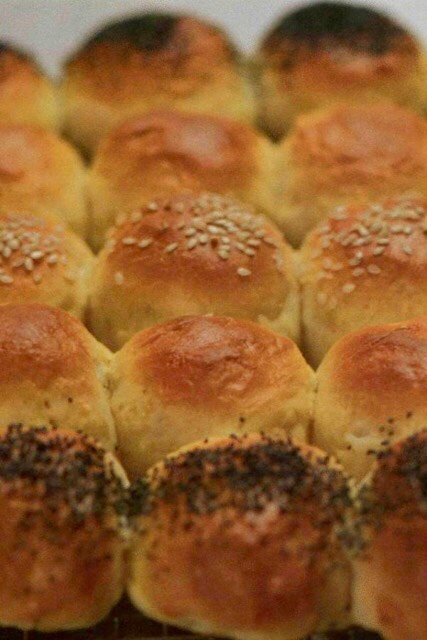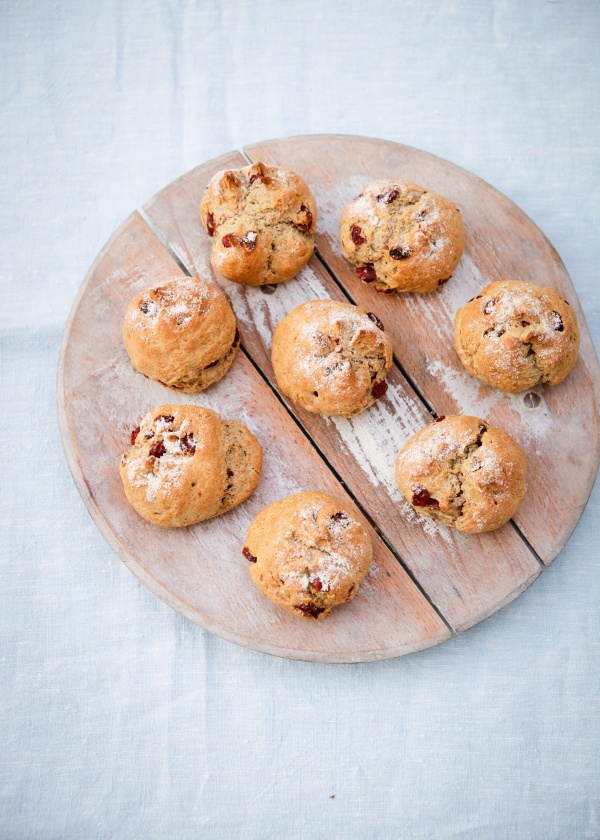Knishes - Ashkenazi Buns with Potato and Sour Cream
by Alissa Timoshkina, featured in Kapusta Published by QuadrilleIntroduction
I usually don’t play favourites with my food, but I am afraid I have to say that Slavic piroshki stand no chance against their Ashkenazi siblings – knishes. I have to confess, as someone who grew up eating piroshki, it never crossed my mind to make knishes. However, once I did, my heart was won over. Very quick and relatively easy to make, these little bundles boast the most perfect flaky buttery pastry and can be filled with anything from mince meat to mashed potatoes, sauerkraut, mushrooms and buckwheat; some recipes also offer sweet alternatives of twarog and jam. Consumed as a snack or a side to a soup, knishes are usually baked but can also be deep-fried.
Knishes hail from the Ashkenazi diaspora in Ukraine, Belarus and Poland, where they are known as knysh or knysz (the word’s etymology goes back to German knitschen to ‘crumple’), and they were popularised worldwide by the Ashkenazi immigrants to the USA in the early 20th century. New York is their hometown and if you happen to be there, make sure to pay a visit to the Yonah Schimmel Knish Bakery, steeped in over 100 years of Ashkenazi history, and the only surviving knish bakery in what used to be Manhattan’s Knish Alley. Having fallen out of favour over the last several decades, the humble buns are said to be making a comeback, so there is no better time than now to join the fan club with me.
I usually don’t play favourites with my food, but I am afraid I have to say that Slavic piroshki stand no chance against their Ashkenazi siblings – knishes. I have to confess, as someone who grew up eating piroshki, it never crossed my mind to make knishes. However, once I did, my heart was won over. Very quick and relatively easy to make, these little bundles boast the most perfect flaky buttery pastry and can be filled with anything from mince meat to mashed potatoes, sauerkraut, mushrooms and buckwheat; some recipes also offer sweet alternatives of twarog and jam. Consumed as a snack or a side to a soup, knishes are usually baked but can also be deep-fried.
Knishes hail from the Ashkenazi diaspora in Ukraine, Belarus and Poland, where they are known as knysh or knysz (the word’s etymology goes back to German knitschen to ‘crumple’), and they were popularised worldwide by the Ashkenazi immigrants to the USA in the early 20th century. New York is their hometown and if you happen to be there, make sure to pay a visit to the Yonah Schimmel Knish Bakery, steeped in over 100 years of Ashkenazi history, and the only surviving knish bakery in what used to be Manhattan’s Knish Alley. Having fallen out of favour over the last several decades, the humble buns are said to be making a comeback, so there is no better time than now to join the fan club with me.

Share or save this
Ingredients
Makes: 14
FOR THE FILLING
- vegetable oil (for frying)
- 50 grams butter
- 2 onions (peeled and thinly sliced)
- 1 teaspoon caster sugar
- 4 - 5 potatoes (peeled and quartered)
- 4 tablespoons sour cream
- 2 tablespoons chopped chives or dill
- salt and black pepper (to taste)
FOR THE DOUGH
- 350 grams plain flour (plus extra for dusting)
- 1 teaspoon baking powder
- ½ teaspoon fine salt
- ½ teaspoon caster sugar
- 1 large egg slightly beaten, plus 1 egg mixed with a splash of water for egg wash
- 120 millilitres warm water
FOR THE FILLING
- vegetable oil (for frying)
- 1¾ ounces butter
- 2 onions (peeled and thinly sliced)
- 1 teaspoon superfine sugar
- 4 - 5 potatoes (peeled and quartered)
- 4 tablespoons sour cream
- 2 tablespoons chopped chives or dill
- salt and black pepper (to taste)
FOR THE DOUGH
- 12½ ounces all-purpose flour (plus extra for dusting)
- 1 teaspoon baking powder
- ½ teaspoon fine salt
- ½ teaspoon superfine sugar
- 1 large egg slightly beaten, plus 1 egg mixed with a splash of water for egg wash
- 4 fluid ounces warm water
Method
Knishes - Ashkenazi Buns with Potato and Sour Cream is a guest recipe by Alissa Timoshkina so we are not able to answer questions regarding this recipe
- Start by making the filling. Heat a little oil in a frying pan, add 10g (¼oz) of butter and fry the onion with a pinch of salt and the sugar over a low heat, stirring occasionally, for 30 minutes or until soft and caramelised.
- Place the potatoes in a large saucepan of cold salted water, bring to boil and simmer for 25 minutes, or until cooked but still firm.
- To make the dough, mix together the dry ingredients in a large bowl.
- In another bowl, mix the wet ingredients. Make a well in the dry ingredients and pour in the wet mixture. Start mixing with a spoon first, then use your hands to gradually incorporate the ingredients to form a dough. Once it comes together into a ball, tip on to a clean, dry dusted surface and knead for 2–3 minutes. Put back into the bowl, cover with clingfilm and let rest while you get back to the filling.
- Drain the potatoes, add the remaining 40g (1½oz) butter, and mash roughly with a potato masher. Add the rest of the ingredients and give a thorough mix. Set aside to cool down, while you get back to the dough.
- Preheat the oven to 180°C (350°F).
- Divide the dough into two halves. Put one back into the bowl and cover with clingfilm while you work with the other half. Dust the surface with some flour and roll the dough out into a large rectangle, as thin as you possibly can. Some traditional Jewish recipes recommend making it as thin as a table cloth. Trim off the wonky edges.
- Take half the filling and shape it into a log across the longest side of the dough rectangle, roughly 1cm (½in) from the edge of the dough. Pull the dough over the filling and continue rolling until the log is lying in front of you, seam-side down.
- Keep rolling it back and forth to make sure the filling is evenly distributed and the seam is not as pronounced. Pinch the ends and cut off any excess dough.
- Now comes the fun part... If you have a good eye for proportion, divide the log into equal segments of roughly 6–7cm (2½–2¾in) long: make subtle incisions with the blunt end of the knife, but don’t cut all the way through.
- Next, use the side of your hand to cut through the incisions and seal each bun that way. Pick up each knish, seal the bottom and the top and squash it a little to give it that distinct knish shape.
- Place on a baking sheet, leaving a bit of space in between, and make a little indentation in the middle of each knish with your thumb. Brush generously with egg wash and bake for 45 minutes, rotating halfway through.
- Allow to cool a little before serving. These taste best warm or at room temperature.
- Start by making the filling. Heat a little oil in a frying pan, add 10g (¼oz) of butter and fry the onion with a pinch of salt and the sugar over a low heat, stirring occasionally, for 30 minutes or until soft and caramelised.
- Place the potatoes in a large saucepan of cold salted water, bring to boil and simmer for 25 minutes, or until cooked but still firm.
- To make the dough, mix together the dry ingredients in a large bowl.
- In another bowl, mix the wet ingredients. Make a well in the dry ingredients and pour in the wet mixture. Start mixing with a spoon first, then use your hands to gradually incorporate the ingredients to form a dough. Once it comes together into a ball, tip on to a clean, dry dusted surface and knead for 2–3 minutes. Put back into the bowl, cover with clingfilm and let rest while you get back to the filling.
- Drain the potatoes, add the remaining 40g (1½oz) butter, and mash roughly with a potato masher. Add the rest of the ingredients and give a thorough mix. Set aside to cool down, while you get back to the dough.
- Preheat the oven to 180°C (350°F).
- Divide the dough into two halves. Put one back into the bowl and cover with clingfilm while you work with the other half. Dust the surface with some flour and roll the dough out into a large rectangle, as thin as you possibly can. Some traditional Jewish recipes recommend making it as thin as a table cloth. Trim off the wonky edges.
- Take half the filling and shape it into a log across the longest side of the dough rectangle, roughly 1cm (½in) from the edge of the dough. Pull the dough over the filling and continue rolling until the log is lying in front of you, seam-side down.
- Keep rolling it back and forth to make sure the filling is evenly distributed and the seam is not as pronounced. Pinch the ends and cut off any excess dough.
- Now comes the fun part... If you have a good eye for proportion, divide the log into equal segments of roughly 6–7cm (2½–2¾in) long: make subtle incisions with the blunt end of the knife, but don’t cut all the way through.
- Next, use the side of your hand to cut through the incisions and seal each bun that way. Pick up each knish, seal the bottom and the top and squash it a little to give it that distinct knish shape.
- Place on a baking sheet, leaving a bit of space in between, and make a little indentation in the middle of each knish with your thumb. Brush generously with egg wash and bake for 45 minutes, rotating halfway through.
- Allow to cool a little before serving. These taste best warm or at room temperature.






Tell us what you think
Thank you {% member.data['first-name'] %}.
Explore more recipesYour comment has been submitted.